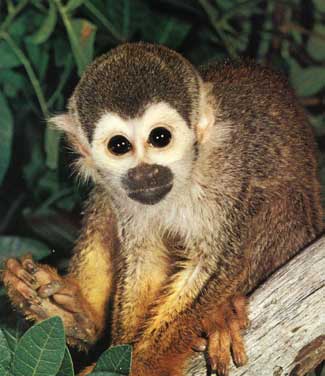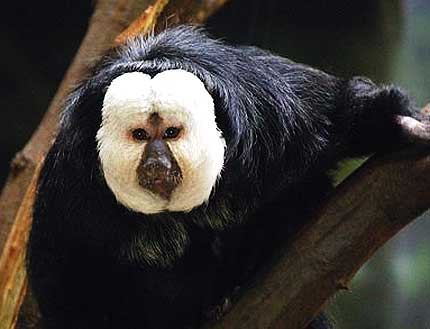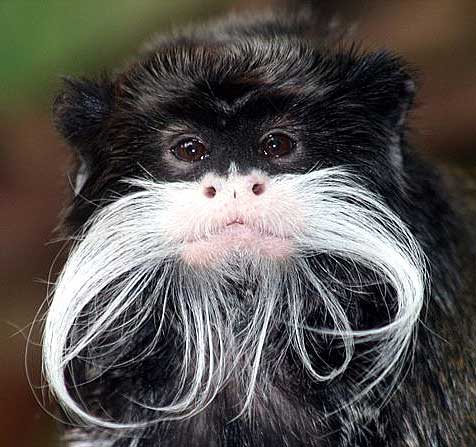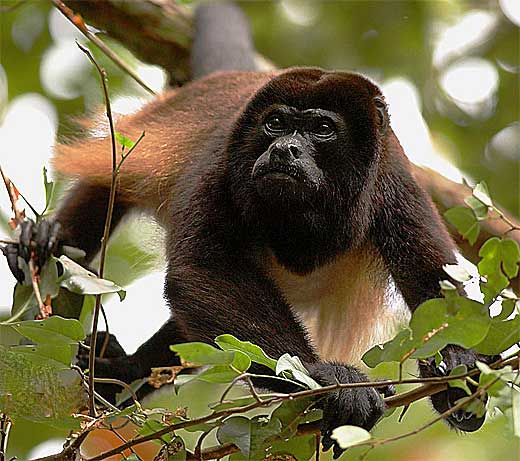Pygmy Marmoset - The Smallest Monkey

They inhabit the Amazon rain forest in Colombia, Ecuador, Bolivia, Peru and Brazil. They scramble about like squirrels in the deep rain forest and drink the sap of trees. Since they are so tiny they can climb very high up in the trees on slender branches to find untapped sources of food - the sap and gum of trees. Ever see gum Arabic listed in the ingredients of food products? It is a commercially available exudates from acacia trees that these little monkeys are happy to eat straight without any mixers. They also like to eat grasshoppers and some other insects when available. They enjoy a view of the water and prefer forests that may have a riverfront view or else flood-plain.
They communicate by making high pitched clicks, squeaks, whistles and trills. In fact they can make noises that are so high pitch that humans can't even hear them. They do have a language of sorts, where certain types of calls and squeaks signify danger or other important monkey communications.
Squirrel Monkeys

Squirrel Monkeys are some of the most common monkeys in South and Central American rainforests. They have a very large range throughout the Amazon and other rainforests. They live in groups of 10-70 but have been seen in groups as large as 100-300 individuals. The groups are split up into adult male bands, groups of mothers with their young, and juvenile bands. Mothers with their young seem to form the core of their society but neither males or females try to dominate. Adult males come around to intermingle with the females during the several months of year that mating occurs.
Squirrel monkeys are shy, non-aggressive and silent but make little squeaks and peeps at times and may shriek if they are in danger. They generally stay in the tree canopies but may occasionally come down to the ground to look for food. They have long tails which they use for support and balance as they are agile climbers and leapers. They also have hairy ears.
Spider Monkeys - Jungle Acrobats, High Swingers

The spider monkey is just that - spidery. Mostly dark brown and black all over they have long tails, spindly legs, little pot bellies, little heads, long hands and bare faces. They make their way through the jungle swinging acrobatically with their gangly long arms.
They live in dense, wet, tropical forest and crash through the canopy barking and screaming to other members of their pack. From Mexico south to Columbia the monkey lives but in the last 10 years their numbers have been reduced by 20 percent due to habitat destruction.
At night they gather in groups as large as 35 to sleep clustered together in the trees. During they day they usually split up into smaller groups to go foraging for food. They look for juicy fruits mostly and eat a few seeds and leaves.
They can share the same territory with howler monkeys peacefully, even acting friendly. The spider males do fight each other a bit when it comes to mating season. And they may shout and throw things at humans.
Saki Monkey - Thick, Long-Coated Fuzzy Face

Saki Monkey is a more common name for any primate that is a member of the Pithecia genus. There are 8 saki species in this group and there are also 5 in another genus - Chiropotes or “bearded sakis”. They live all across South America from South Colombia to Central Brazil. They are arboreal and live in the trees of rainforest regions.
They are diurnal meaning they are active during daylight hours and at rest in the night time. They move mainly on all fours and roll themselves up into a small ball when sleeping. Very rarely will they leave the trees and walk along the ground and very occasionally they run in an upright position on their hind legs. Like many other monkeys, this genus is very shy, cautious and prefers to remain hidden.Saki monkeys are omnivorous meaning they’ll eat a range of foods from fruits and nuts to small mammals and insects. Their main diet consists of fruit but they’ll add-in some other foods too. They live in small family groups comprised of a mating pair and their offspring. Usually monogamous, they stay in the same mating pair for their entire lives. They are a very territorial group and are very protective of their homes in the face of other families. They communicate via twittering shrill cries and when they roar, it means they’re warning off other monkeys from their territory.They live up to thirty years and their young are fully mature at about three years old. They mate whenever they feel like it and there is no specific mating period. The gestational period is approximately 150-170 days and they give birth to a single offspring.
Emperor Tamarin - Small Creature, Big Fu Manchu

The emperor tamarin is a new world monkey found in Central and South America. It is known as "the emperor" because of its odd, humorous looking white moustache (even females and the little ones are born with stubble). The majority of the rest of its fur is gray with yellow/brown speckles.
There are two species within the emperor tamarin group: the black-chinned and the bearded. There are few differences between the two types except for this all important chin fashion. The grow up to 10 inches (25 cm) and can reach up to 1 lb (450 g) in weight. Their tails are much longer than their bodies. These statistics show they’re very small animals, but that doesn't mean they can't be fashionable.
This is social monkey. Generally, they live in groups of two to ten animals. They live in a matriarchal society which means the oldest female leads the group and is the most senior and important member of the group. The mature males then follow in her wake and the young bring up the rear. Like many primates, this species partakes in mutual grooming for social purposes and to bond with the others in its group. They have various shrill and shrieking cries to warn off others from their group. They are a very territorial species and defend their land aggressively against other tamarins and small monkeys
Their diet consists mainly of fruit complemented by a small proportion of nectar in the wet seasons. When the dry seasons come round nectar becomes a more integral part of the diet. They will also eat insects (crickets are a favorite), snails and ants if they need to and are opportunistic when it comes to their food.The female emperor tamarin has a gestational period of about 145 days and normally gives birth to two young. The offspring are cared for by all members of the group including the mature males. The males are the ones who carry the offspring except when they are suckling. The average lifespan of this species is around 15 years although they are known to live up to 20.
Howler Monkeys - Jungle Noisemakers - World's Loudest Animal?

Howler monkeys define the jungles of the Americas with their ruckus. Without their throaty howl it wouldn’t be the same. As the sun rises, the howlers inflate their throat sacs like great wind instruments and bellow a haunting, deafening call that can carry for miles (as many as 10). They are perhaps the loudest animals on land. Howling is mostly an activity for the males but the females vocalize a little too.
Then when they finish with their morning howl they start foraging for breakfast. They chew and climb slowly, taking days to cover the square kilometer expanse of a group’s range. A male, female, their young, and the whole clan will slowly move along in the upper jungle branches. They crawl along, not leaping and swinging like spider monkeys, and tend to use their favorite paths over and over. They almost always have a good grip on things with their long prehensile tails. They can spend long hours gazing into the jungle. Apparently, their diet of fruit and leaves is not very energizing for these big monkeys and they can sleep as much as 15 hours in a day. They are the largest monkeys in the Americas.
Thanks to sounding off and listening for other group's vocalizations they won’t have to run into any other groups of howler monkeys that they would rather stay away from. They would do well to stay away from some people as well because they have been hunted for their meat in the past. With the noise they make, large size and inactivity, they don’t make very good pets.
When a mother gives birth all the females of the clan gather around to have a look. The newborns hang on to the mothers back for about a year. After another six months to a year the mother lets the newborn know with a snarl or a slap that it is time to for them to become more independent and hang out with the other members of the clan. Meanwhile the mother gets ready for her next young one.
No comments:
Post a Comment